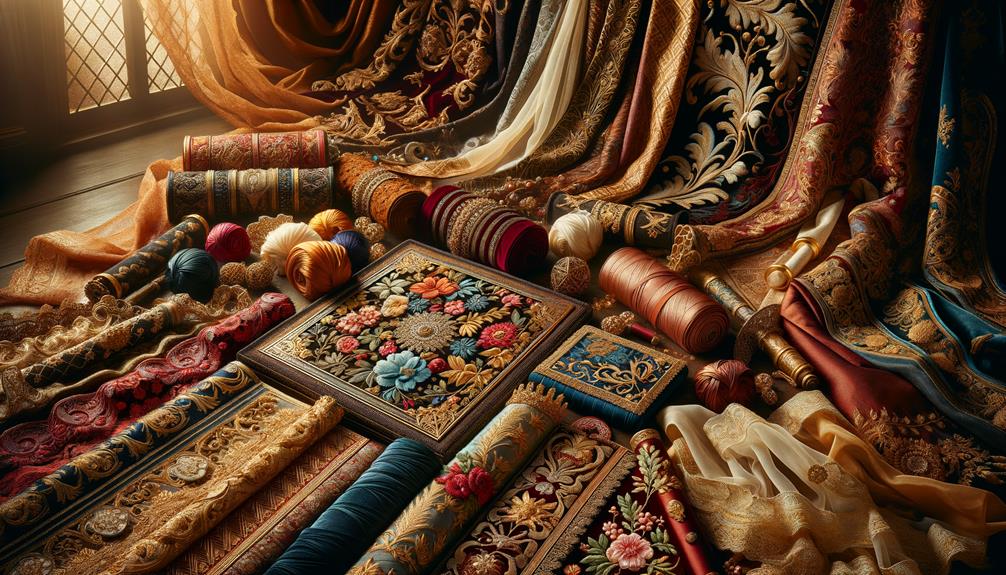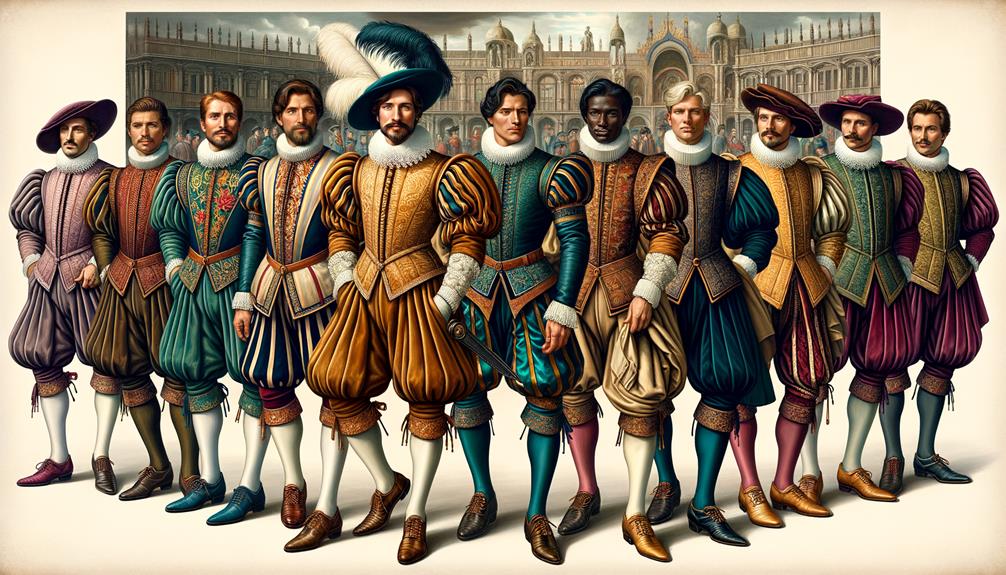Renaissance tailoring techniques have always fascinated me with their unique blend of artistry and precision. When creating garments, tailors would first draft patterns on a linen mock-up, using precise measurements to ensure a perfect fit. They would then transfer these designs using methods like pouncing and pricking, which ensured accuracy. For bodices, they used cotton satin, layering felt for structure, and whip-stitched the armholes for added strength. Skirts were pleated and sewn seamlessly to bodices, often using linen tape closures. To add an extra touch of luxury, embellishments like gold braids and intricate embroidery were used. The attention to detail in these garments is truly remarkable, making them a testament to the skill of Renaissance tailors.
Drafting Patterns
When drafting patterns, Renaissance tailors would often start by sketching directly onto a linen mock-up, ensuring every detail was precise. I find this approach fascinating because it combines precision with a tangible understanding of the garment’s final form. The techniques used in pattern drafting involved meticulous measuring and marking, often referencing existing garments to guarantee historical accuracy.
The materials used played a crucial role in this process. For instance, cotton satin was a preferred fabric for bodices due to its smooth texture and slight sheen. To provide structure, tailors layered felt and cotton batting, which were then cut with precision. Seam allowances were carefully calculated and marked, showcasing the tailor’s foresight in accommodating the garment’s eventual assembly.
Cutting fabric wasn’t just about following lines; it was an act of transforming flat material into a three-dimensional masterpiece. The attention to detail in these techniques reflects not only the craftsmanship but also the innovative spirit of the time. By basting layers together and pad-stitching the cotton batting, the tailors could shape the garment effectively, ensuring it met the high standards of Renaissance fashion.
Pattern Transfer Methods
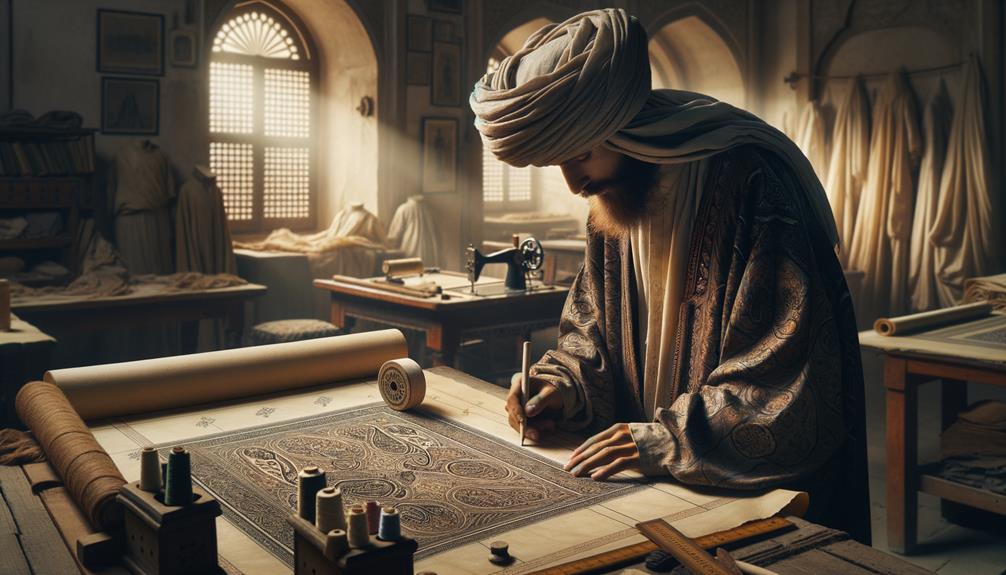
When I think about Renaissance-era tailors transferring patterns onto fabric, two techniques stand out: pricking and pouncing. Imagine meticulously perforating a paper pattern, then dusting charcoal through the holes or using a pounce bag filled with chalk to rub over those perforations. These methods, along with tracing patterns using soap, allowed for remarkable precision and consistency in garment creation.
Pouncing and Pricking
Pouncing and Pricking
In the world of Renaissance tailoring, two indispensable techniques were used to transfer intricate patterns onto fabric with remarkable precision. As I delve into these methods, I’m struck by their simplicity and effectiveness. Pouncing, for instance, involves using a paper pattern with small holes punched along the design lines. By dusting chalk or fine powder through these perforations, tailors could effortlessly transfer the pattern onto the fabric beneath. This method provided a clean, visible guideline for subsequent cutting and sewing.
Pricking, on the other hand, required a more direct approach. Tailors would pierce holes along the lines of the paper pattern, directly marking the fabric. This method allowed for a tactile, almost meditative experience, as each prick created a tangible link between the design and the material. The precision achieved through pricking was extraordinary, enabling tailors to replicate intricate details with unmatched accuracy.
Both techniques were crucial in the Renaissance, where the demand for elaborate and finely crafted garments was high. These methods provided a reliable way to transfer complex designs, ensuring that every piece of fabric was prepared with meticulous care. The ingenuity behind pouncing and pricking continues to inspire modern tailoring practices, reminding us of the timeless quest for perfection in garment construction.
Tracing With Soap
Tracing with soap, a delicate yet effective method from the Renaissance, allows for precise pattern transfer onto fabric without causing damage. As I carefully glide the soap along the fabric, I’m reminded of the elegance and precision that Renaissance tailoring techniques embody. The soap leaves a faint, visible line that guides my scissors and needles, ensuring accurate cuts and stitches.
This method is not only gentle on the fabric but also practical. The soap marks can be easily washed away with water once the garment is complete, leaving no trace of the initial lines. It’s fascinating how such a simple material can play a crucial role in the intricate process of garment construction.
In today’s fast-paced world, tracing with soap stands as a testament to the ingenuity of Renaissance tailors. They mastered techniques that combined functionality with respect for the materials they worked with. Embracing this method in contemporary tailoring allows us to connect with the past while achieving meticulous pattern transfer. It’s a beautiful blend of history and innovation, proving that sometimes simple tools yield remarkable results.
Bodice Construction
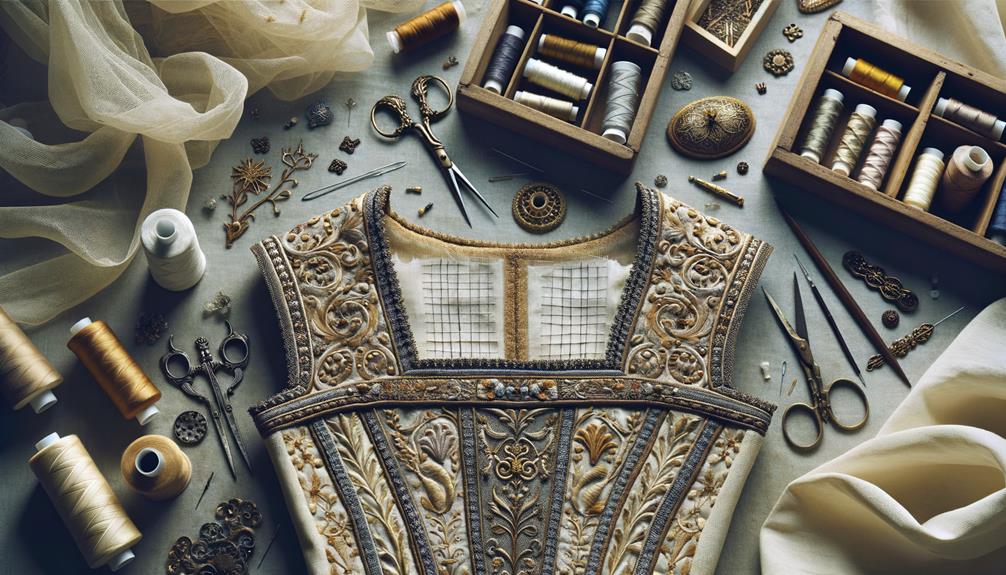
When I think about bodice construction in the Renaissance, I’m always struck by the careful selection of fabrics like linen camicha and cotton satin, which provided both structure and comfort. Historical sewing methods, such as whip-stitching armholes and using linen tape closures, ensured durability and a secure fit. While adjustments were often necessary, the attention to detail in pleating and hemming made each piece a work of art.
Historical Sewing Methods
Crafting a Renaissance bodice demands attention to period-specific techniques that combine functionality with artistry, ensuring a perfect fit and durability. Historical sewing methods during this era were characterized by careful planning and meticulous execution.
One notable tailoring technique of the time was the use of linen tape closures and silk-threaded eyelets for fastening bodices. These methods provided flexibility and strength, essential for the tight fits and elaborate designs typical of Renaissance fashion. Bodice construction also involved careful management of seam allowances, which were often tucked inward to present a clean finish.
Skirt construction was equally elaborate, with selvages used as seam allowances to enhance the garment’s structural integrity. Pleating the waist edge and attaching it to the bodice with eyelets was a common practice, ensuring a seamless transition from bodice to skirt.
Key Renaissance bodice construction techniques include:
- Seam allowances tucked inward for a clean, durable finish.
- Linen tape closures and silk-threaded eyelets for flexible yet strong fastening.
- Whip-stitched armholes for added durability and strength.
These historical methods offer a fascinating glimpse into the craftsmanship and innovation of Renaissance tailoring.
Fabric Choices Explained
Fabric Choices Explained
When it comes to Renaissance bodice construction, the selection of fabrics was a meticulous process that balanced aesthetics and functionality. Cotton satin was the primary fabric of choice, prized for its smooth, lustrous finish that exuded elegance. This choice wasn’t accidental; cotton satin’s durability and sheen provided the bodice with a luxurious appearance while withstanding wear and tear.
To achieve the desired rigidity, felt and cotton batting were carefully layered beneath the satin. The felt was often treated with a gum arabic mixture, allowing for intricate painting and adding an artistic touch to the garment. This mixture not only stiffened the felt but also provided a canvas for decorative elements, enhancing the bodice’s visual appeal.
Closures were equally thoughtful. Linen tape closures offered a sturdy, reliable method to fasten the bodice, while silk thread eyelets provided a delicate yet strong solution for lacing. The attention to detail extended to the construction process itself, with seam allowances tucked inward and armholes whip-stitched, ensuring a clean, polished finish. Each fabric choice and technique highlighted the Renaissance emphasis on both beauty and utility, a balance that continues to inspire modern tailoring innovations.
Fit and Adjustments
Achieving a close and flattering fit in Renaissance bodice construction required meticulous attention to detail and a deep understanding of the body’s contours. It’s fascinating to see how tailors of the time managed to create garments that fit so perfectly without relying on modern conveniences.
The key to their success lay in precise adjustments and smart use of materials. To guarantee a seamless fit, seam allowances were carefully tucked inward, and armholes were whip-stitched. This not only provided a clean finish but also enhanced the garment’s durability. The fastening methods were another stroke of genius. Linen tape closures and silk thread eyelets were commonly used, allowing for a snug fit that could be easily adjusted.
Three techniques stood out to me:
Seam allowances were tucked inward for a clean finish. Linen tape closures and silk thread eyelets were used for adjustable fastening. Hemming techniques incorporated turned hems with gold braid embellishments.
The final touch often involved hemming techniques that added decorative elements, such as turned hems adorned with gold braid. These methods guaranteed that each bodice was not just functional but also a work of art.
Skirt Assembly
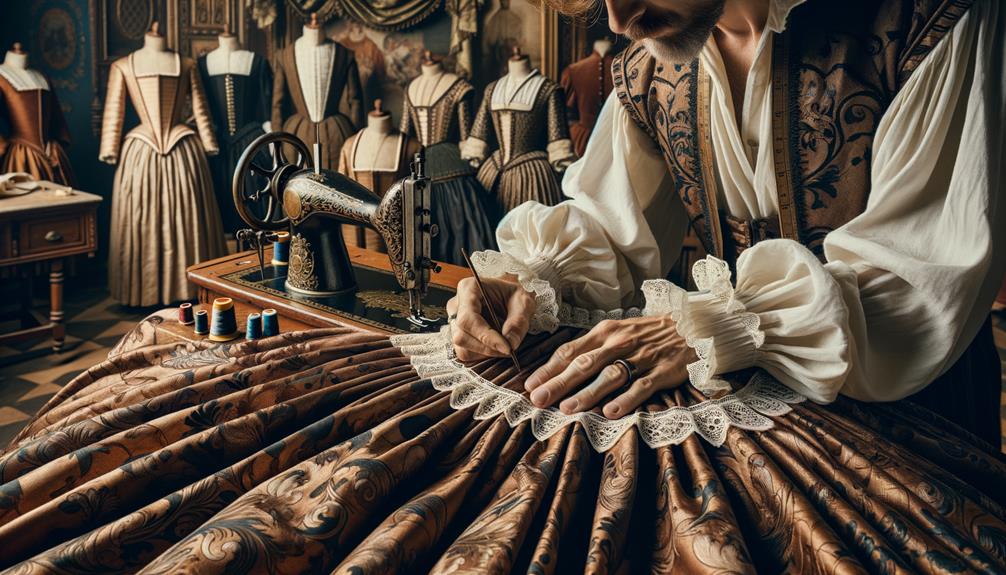
Assembling a skirt in Renaissance tailoring is a meticulous process that requires precision and artistry. The key to creating fullness is in the pleating of the waist edge, which demands a deep understanding of fabric behavior and tension. I find pleasure in pleating, as it’s a delicate balance of technique and creativity.
Seam allowances play a vital role in skirt assembly. By cleverly hiding them within the construction, often using selvages, the result is a clean, polished finish that sets Renaissance garments apart. Next, eyelets provide a practical solution for attaching the skirt to the bodice, offering adjustability and ease of movement.
Tuck planning is another crucial component, adding structure and shape to the skirt. Each tuck must be thoughtfully placed to enhance the garment’s overall silhouette. Finally, the hemming techniques used during this era are exquisite. A beautifully turned hem, often adorned with gold braid, adds the final touch of luxury.
Throughout the skirt assembly process, from pleating to hemming, I’m struck by the innovation and craftsmanship that defined Renaissance tailoring.
Stitching Techniques
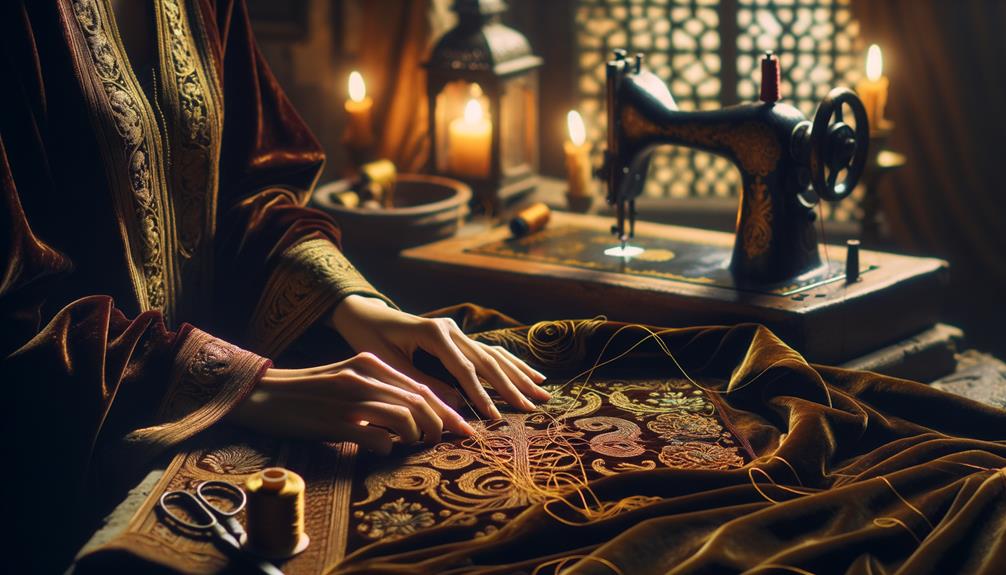
Renaissance stitching techniques showcase a profound dedication to artistry and precision in garment construction. Each stitch tells a story of innovation and mastery, blending function and beauty seamlessly.
The tailors of the Renaissance were masters of their craft, using precise stitching to create garments that stood the test of time. They often employed hand-bound eyelet holes and machine seams, which required a level of accuracy that’s truly admirable. Cartridge pleating was another popular method, allowing tailors to add fullness to garments without sacrificing elegance.
Three fascinating aspects of Renaissance stitching techniques are:
- Embroidery Stitches: These stitches weren’t just decorative; they also reinforced the fabric, adding both beauty and durability.
- Appliqué: This technique involved layering fabrics to create intricate patterns and designs, showcasing the tailor’s artistic flair.
- Cartridge Pleating: This method created voluminous skirts and sleeves, demonstrating the tailor’s skill in manipulating fabric.
Smaller seam allowances back then meant no room for error, making the precision in stitching all the more impressive. Understanding gores, gussets, and inserts was essential, ensuring a perfect fit and design.
Embellishment Details
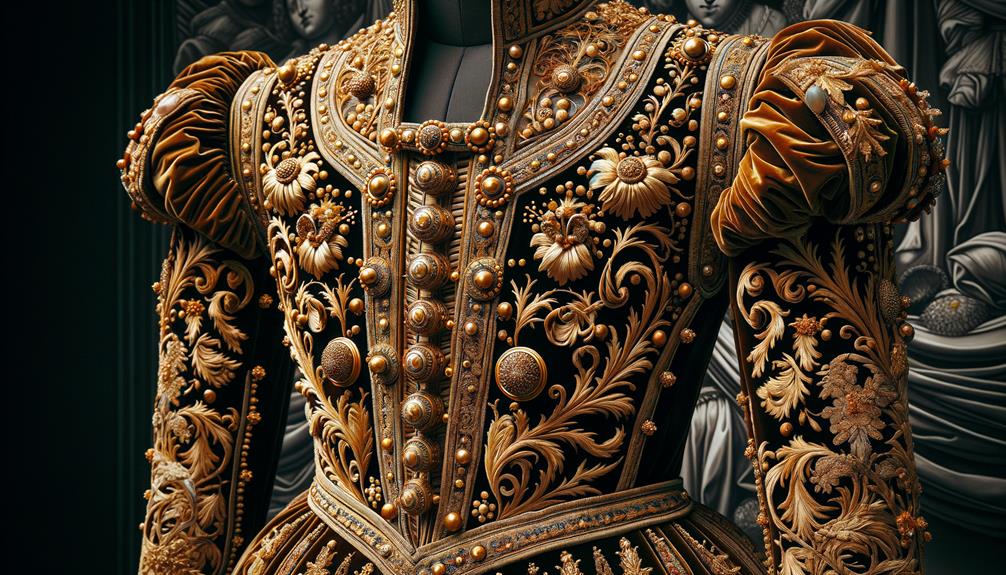
Throughout my exploration of Renaissance embellishments, I’ve been struck by the sheer opulence and meticulous craftsmanship that defines this era. Gold braid designs, for instance, are a testament to the era’s love of luxury. These intricate patterns, couched with silk thread, don’t just embellish the fabric; they convey a sense of wealth and status. I’ve come across tutorials that break down the creation of finger loop braids, crafted from cotton embroidery, which add both texture and visual interest, highlighting the skill involved in Renaissance embellishments.
The significance of gold egglets from Burnley and Trowbridge cannot be overstated. These tiny, ornate elements are like the jewels in the crown, elevating the luxurious look of any garment they adorn. Gold-wrapped silk braids further enhance this sense of opulence, their shimmering threads catching the light and creating a dynamic interplay that makes the fabric seem almost alive.
Each embellishment detail, from the humble finger loop braid to the resplendent gold egglets, showcases an era that thrived on innovation and artistic expression. In studying these Renaissance embellishments, I’ve gained an appreciation for how these intricate details contribute to the garment’s overall splendor.
Frequently Asked Questions
What Were the Features of Renaissance Fashion?
Renaissance fashion was all about drama and luxury. Women’s clothing featured intricately constructed bodices, linen camicha, and gowns adorned with gold braids, creating a truly regal look. The use of pleated skirts and detailed embellishments turned each garment into a work of art.
What Are Tailoring Techniques?
Tailoring techniques – the art of cutting, sewing, and hoping that your creations turn out better than a kindergartener’s art project. I measure, draft patterns, and stitch, praying that my garments don’t end up looking like they were put together by a blind person having a seizure.
What Are the Types of Tailoring?
When I think about tailoring, I envision a range of techniques that cater to different needs and preferences. Bespoke tailoring offers custom fits, made-to-measure provides personalized designs, and off-the-rack provides convenience. Each approach brings its own unique craftsmanship and innovation to garment creation.
What Was a Tailor in the Middle Ages?
A tailor in the Middle Ages was a skilled professional who took precise measurements to create custom clothing that fit individual clients perfectly. They combined technical expertise with creativity to meet the unique needs of each customer.



